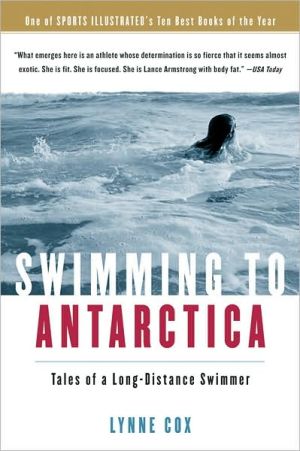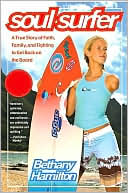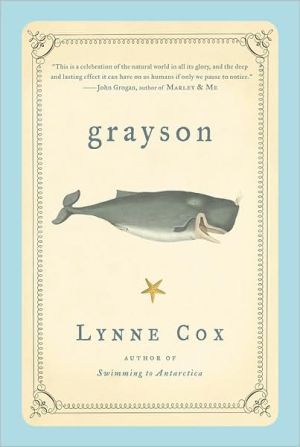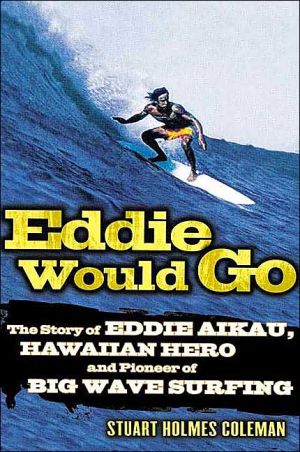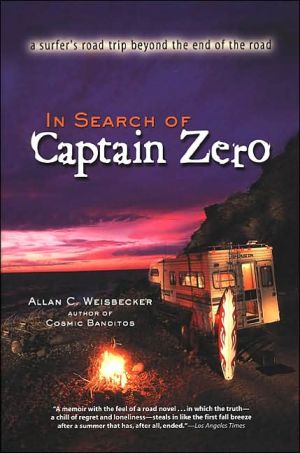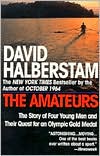Swimming to Antarctica: Tales of a Long-Distance Swimmer
Now in paperback, with photos and maps added especially for this new edition, here is the acclaimed life story of a woman whose drive and determination inspire everyone she touches.\ Lynne Cox started swimming almost as soon as she could walk. By age sixteen, she had broken all records for swimming the English Channel. Her daring eventually led her to the Bering Strait, where she swam five miles in thirty-eight-degree water in just a swimsuit, cap, and goggles. In between those...
Search in google:
Newly Illustrated with Photos and Maps Throughout (format to separate this phrase from copy)Here is the joyful, inspirational memoir of swimmer Lynne Cox. By age sixteen, she had broken all records for English Channel swims, so she set her goals even higher: She became the first to swim the Strait of Magellan, narrowly escaped a shark attack off the Cape of Good Hope, and was cheered across the twenty-mile Cook Strait of New Zealand by dolphins. Her daring eventually led her to the thirty-eight-degree waters of the Bering Strait, which she crossed in her usual outfit—just a swimsuit, cap, and goggles. She has even swum (LYNN - right verb??) a mile in the iceberg-choked waters of the Antarctic. With a poet's eye for detail, Cox shares the beauty of her time in the water in this new classic of sports memoir."[Cox has] done things the rest of us only imagine—and she's written a book that helps us to imagine them with clarity and wonder."—The Boston Globe"More than the story of the greatest open-water swimmer, Swimming to Antarctica is a portrait of rare and relentless drive. . . .Gripping."—Sports Illustrated"A tale of remarkable physical prowess and heart."—Vogue"Fetching and pitch-perfect . . . Full of perilous, preposterous-if-they-weren't-true scenes." - Outside Magazine "An instant classic of adventure writing."—Minneapolis Star-Tribune"The only things more impressive than her heroics are her magnanimous spirit and ability to bring people together."—Miami Herald"Even a cursory read leaves one shivering for a warm towel."—Entertainment Weekly"A triumph of a positive outlook, hefty preparation, and raw courage."—The Economist"So compelling and immediate that even a non-swimmer can almost feel as if he'd been a participant."—Philadelphia Inquirer LYNNE COX has set records all over the world for open-water swimming. She was named Los Angeles Times Woman of the Year, inducted into the International Swimming Hall of Fame in 2000, and honored with a lifetime achievement award from the University of California—Santa Barbara. She lives in Los Alamitos, California. Publishers Weekly Cox, one of the world's leading long-distance swimmers, has been a risk-taker ever since she was nine and chose the freezing water of a New Hampshire pool in a storm over getting out and doing calisthenics. After her family moved to California so she and her siblings could train as speed swimmers, she discovered long-distance ocean swimming. Her first open-water event, a team race across the Catalina Channel, convinced her to train for the English Channel. At 15, she broke the Channel record, and decided she needed a new goal. Up to this point, Cox's story reads like a fairy tale of hard work, careful planning and good support, crowned with success. It isn't until she competes in the Nile River swim that the tale turns ugly-she's swimming in raw sewage and chemical waste, fending off the dead rats and broken glass, so sick with dysentery she lands in the hospital. Undeterred, she plans more ambitious swims-around the shark-infested Cape of Good Hope, across Alaska's Glacier Bay-to prepare for her big dream, a swim from Alaska to the Soviet Union across the Bering Strait. While offering herself to researchers studying the effects of cold on the human body, her political goals are even larger: to bring countries and peoples together, using swimming "to establish bridges between borders." Cox ends her story with her swim to Antarctica, where she finishes the first Antarctic mile in 32-degree water in 25 minutes. Even though readers know she survived to tell the tale, it's a thrilling, awesome and well-written story. (Jan.) Forecast: Knopf plans lots of media for this inspirational book, including a nine-city author tour, a profile in Biography magazine, an appearance on NPR, ads in USA Today and features in women's, sports and travel magazines. Copyright 2003 Reed Business Information.
"Please. Please. Please, Coach, let us out of the pool, we're freezing," pleaded three purple-lipped eight-year-olds in lane two.\ Coach Muritt scowled at my teammates clinging to the swimming pool wall. Usually this was all he had to do to motivate them, and they'd continue swimming. But this day was different. Ominous black clouds were crouched on the horizon, and the wind was gusting from all different directions. Even though it was a mid-July morning in Manchester, New Hampshire, it felt like it would snow.\ Cupping his large hands against his red face, and covering the wine-colored birthmark on his left cheek, Coach Muritt bellowed, "Get off the wall! Swim!"\ "We're too cold," the boys protested.\ Coach Muritt did not like to be challenged by anyone, let alone three eight-year-old boys. Irritated, he shouted again at the swimmers to get moving, and when they didn't respond, he jogged across the deck with his fist clenched, his thick shoulders hunched against the wind and his short-chopped brown hair standing on end. Anger flashed in his icy blue eyes, and I thought, I'd better swim or I'll get in trouble too, but I wanted to see what was going to happen to the boys.\ Coach Muritt shook his head and shouted, "Swim and you'll get warm!"\ But the boys weren't budging. They were shaking, their teeth chattering.\ "Come on, swim. If you swim, you'll warm up," Coach Muritt coaxed them. He looked up at the sky, then checked his watch, as if trying to decide what to do. In other lanes, swimmers were doing the breaststroke underwater, trying to keep their arms warm. More teammates were stopping at the wall and complaining that they were cold. Laddie and Brooks McQuade, brothers who were always getting into trouble, were breaking rank, climbing out of the pool and doing cannonballs from the deck. Other young boys and girls were joining them.\ "Hey, stop it! Someone's going to get hurt-get your butts back in the water!" Coach Muritt yelled. He knew he was losing control, that he had pushed the team as far as we could go, so he waved us in. When all seventy-five of us reached the wall, he motioned for us to move toward a central lane and then he shouted, "Okay, listen up. Listen up. I'll make a deal with you. If I let you get out now, you will all change into something warm and we'll meet in the boys' locker room. Then we will do two hours of calisthenics."\ Cheering wildly, my teammates leaped out of the pool, scurried across the deck, grabbed towels slung over the chain-link fence surrounding the pool, and squeezed against one another as they tried to be first through the locker room doors.\ Getting out of the water was the last thing in the world I wanted to do. I hated doing calisthenics with the team. Usually we did them five days a week for an hour, after our two-hour swimming workout. A typical workout included five hundred sit-ups, two hundred push-ups, five hundred leg extensions, five hundred half sit-ups, two hundred leg lifts on our backs, and two hundred leg lifts on our stomachs. As we did the exercises, Coach Muritt counted and we had to keep pace with him. Between each set of fifty repetitions, he gave us a one-minute break, but if anyone fell off pace or did the exercises incorrectly, he made us start the set all over again. He wanted to make us tough, teach us discipline and team unity. And I didn't mind that. I liked to work hard, and I liked the challenge of staying on pace, but I detested having to start an exercise all over again because someone else was slacking off or fooling around. Brooks and Laddie McQuade were notorious for that. They were always trying to see how much they could get away with before they got caught. For them, it was a big game. Older boys on the team yelled at them and tossed kickboards at them, but they didn't care; they liked the attention they were getting from the team and the coach. I didn't want to play their game, and I didn't want to do two long hours of calisthenics with them, so I shouted, "Coach Muritt, can I stay in the pool and swim?"\ He was wiping his eyes and nose with a handkerchief, and asked incredulously, "Jeez, aren't you freezing?"\ "If I keep swimming, I'm okay," I said, and smiled, trying my very best to convince him. I was a chubby nine-year-old, and I was a slow swimmer, so I rarely got a chance to stop and take a rest. But because I just kept going, I managed to constantly create body heat, and that way I stayed warm when all the other swimmers were freezing.\ "Is there anyone else who wants to stay in the water?"\ "We do," said three of his Harvard swimmers in lane one.\ During the college season, Muritt coached the Harvard University Swim Team. He was considered to be one of the best coaches in all of New England; at least a dozen of his college swimmers had qualified for the U.S. Nationals. In the summer, most of his college swimmers worked out with our age groupers on the Manchester Swim Team, and they inspired us by their example. Somehow my parents knew from the start that to become your best, you needed to train with the best. And that's why I think they put my older brother, David, me, and my two younger sisters, Laura and Ruth, into Coach Muritt's swimming program.\ Coach Muritt studied the sky, and we followed his gaze. "I still don't like the looks of those clouds," he said pensively.\ "Coach, we'll get out immediately if it starts to thunder. I promise," I said, and held my breath, hoping he wouldn't make me do calisthenics.\ He considered for a moment, but he was distracted by uproarious laughter, high-pitched hoots, and shouts coming from the locker room.\ "Please, Coach Muritt, please can we stay in?" I said.\ "Okay, but I'll have to take the pace clock or it's going to blow over-you'll have to swim at your own pace for the next couple of hours."\ "Thank you, Coach," I said, and clapped my hands; I was doubly thrilled. I had escaped calisthenics and now I was going to be able to swim for three hours straight. I loved swimming and I loved swimming at my own pace, alone in my own lane, with no one kicking water in my face, and no one behind tapping my toes, telling me I had to swim faster. It was a feeling of buoyant freedom. But swimming into a storm was even better; waves were rushing around me, and lifting me, and tossing me from side to side. The wind was howling, slamming against the chain-link fence so strongly that it sounded like the clanging of a warning bell. I felt the vibrations rattle right through my body, and I wondered if the wind would tear the fence from its hinges. Turning on my side to breathe, I checked the sky. It looked like a tornado was approaching, only without the funnel cloud. I wondered for a second if I should climb out of the water. But I pushed that thought away; I didn't want to get out. I was immersed in unbridled energy and supernatural beauty, and I wanted to see what would happen next.\ My world was reduced to the blur of my arms stroking as a cold, driving rain began. The raindrops that hit my lips tasted sweet and cold, and I enjoyed the sensations of every new moment. The pool was no longer a flat, boring rectangle of blue; it was now a place of constant change, a place that I had to continually adjust to as I swam or I'd get big gulps of water instead of air. That day, I realized that nature was strong, beautiful, dramatic, and wonderful, and being out in the water during that storm made me feel somehow a part of it, somehow connected to it.\ When the hail began, the connection diminished considerably. I scrambled for the gutters while the college swimmers leaped out of the water and ran as fast as they could into the locker room. One looked back at me and shouted, "Aren't you getting out?"\ "No, I don't want to," I said, crawling into the gutter by the stairs. The hail came down so fast and hard that all I heard was the rush and pinging of the stones as they hit the deck and pool. Thankful for the white bathing cap and goggles protecting my head and eyes, I covered my cheeks with my hands. Hailstones the size of frozen peas blasted my hands, neck, and shoulders, and I winced and cringed and tried to squeeze into a tighter ball, hoping that it would be over soon.\ When the hail finally changed to a heavy rain, I crawled out of the gutter and started swimming again. As I pulled my arms through the water, I felt as if I were swimming through a giant bowl of icy tapioca. The hailstones floated to the water's surface and rolled around my body as I swam through them. I realized that by putting myself in a situation different from everyone else's, I had experienced something different, beautiful, and amazing.\ In the parking lot outside, I saw Mrs. Milligan sitting in her car with her headlights aimed at me. Mrs. Milligan was Joyce's mother, and Joyce was the fastest and nicest girl on the team. Joyce had qualified for nationals a couple of times, and I wanted to be just like her. Once I'd asked her why she was so fast. She'd said that she did what Coach Muritt asked of her. It was such a simple statement, but one that was a revelation for me. If I did what Joyce did, then maybe I could also make it to nationals. I wondered how long Mrs. Milligan had been watching me. When I saw my teammates poking their heads out of the locker room, I knew the workout was over, so I climbed out of the pool.\ Copyright © 2004 by Lynne Cox\ All rights reserved. No part of this publication may be reproduced or transmitted in any form or by any means, electronic or mechanical,\ including photocopy, recording, or any information storage and retrieval system, without permission in writing from the publisher.\ Requests for permission to make copies of any part of the work should be mailed to the following address: Permissions Department,\ Harcourt, Inc., 6277 Sea Harbor Drive, Orlando, Florida 32887-6777.
Prologue: A Cold Day in August 1Beginnings 7Leaving Home 14Open Water 27Twenty-six Miles Across the Sea 40English Channel 57White Cliffs of Dover 69Homecoming 95Invitation to Egypt 102Lost in the Fog 124Cook Strait, New Zealand 134Human Research Subject 146The Strait of Magellan 160Around the Cape of Good Hope 177Around the World in Eighty Days 194Glacier Bay 204Facing the Bomb 224The A-Team 234Mind-Blowing 248Debate 265Across the Bering Strait 282Success 302Siberia's Gold Medal 307Swimming to Antarctica 314Afterword 358
\ From Barnes & NobleThe Barnes & Noble Review\ A world-class athlete on the order of cyclist Lance Armstrong or triathlon champ Mark Allen, Lynn Cox has accomplished some amazing goals during her extraordinary career as a long-distance swimmer. At 15, she crossed the English Channel in record time; she was the first swimmer to navigate the Strait of Magellan and to round the Cape of Good Hope; and in 1987, she fulfilled a lifelong dream by swimming across the Bering Strait as a gesture of goodwill between the U.S. and Russia. But beyond the thrill of breaking records and meeting challenges, Cox is driven by her spirit of adventure and a boundless love of the open sea -- a mysterious, mutable medium that produces in her an almost Zen-like bliss that radiates from every page of this delightful memoir. \ In sparkling prose that evokes each euphoric moment, she recounts the highlights of an astonishing career that began at age 14 with her first nighttime swim in the phosphorescent waters of Catalina Channel, where flying fish sailed over her head in giddy, iridescent arcs. Buoyed -- literally -- by a perfectly balanced ratio of body fat to muscle, Cox's plump physique endowed her with an unusual tolerance for cold water, motivating her to undertake ever more ambitious challenges culminating in the event of the book's title: her historic one-mile swim to Antarctica in bone-numbing 32-degree waters.\ Shot through with colorful portraits of family and friends and vignettes of the daunting challenges she has faced (dead rats, treacherous whirlpools, man-eating sharks, and glacial ice, to name a few), Cox's autobiography also includes fascinating tidbits of meteorological, navigational, and medical arcana. Dive into it for a mesmerizing read! Anne Markowski\ \ \ \ \ \ Oliver SacksThrilling , vivid, and lyrical, an inspiring account of a life of aspiration and adventure.\ \ \ Sports IllustratedGripping reading...Swimming to Antaritica is a portrait of rare and relentless drive.\ \ \ \ \ Minneapolis Star Tribune"All of [her] superhuman escapades are vividly detailed in Cox's absorbing memoir."\ \ \ \ \ Portland Oregonian"An absorbing, well-written memoir. The paperback edition is even better than the hardcover, with more maps and photographs."\ \ \ \ \ Publishers WeeklyCox, one of the world's leading long-distance swimmers, has been a risk-taker ever since she was nine and chose the freezing water of a New Hampshire pool in a storm over getting out and doing calisthenics. After her family moved to California so she and her siblings could train as speed swimmers, she discovered long-distance ocean swimming. Her first open-water event, a team race across the Catalina Channel, convinced her to train for the English Channel. At 15, she broke the Channel record, and decided she needed a new goal. Up to this point, Cox's story reads like a fairy tale of hard work, careful planning and good support, crowned with success. It isn't until she competes in the Nile River swim that the tale turns ugly-she's swimming in raw sewage and chemical waste, fending off the dead rats and broken glass, so sick with dysentery she lands in the hospital. Undeterred, she plans more ambitious swims-around the shark-infested Cape of Good Hope, across Alaska's Glacier Bay-to prepare for her big dream, a swim from Alaska to the Soviet Union across the Bering Strait. While offering herself to researchers studying the effects of cold on the human body, her political goals are even larger: to bring countries and peoples together, using swimming "to establish bridges between borders." Cox ends her story with her swim to Antarctica, where she finishes the first Antarctic mile in 32-degree water in 25 minutes. Even though readers know she survived to tell the tale, it's a thrilling, awesome and well-written story. (Jan.) Forecast: Knopf plans lots of media for this inspirational book, including a nine-city author tour, a profile in Biography magazine, an appearance on NPR, ads in USA Today and features in women's, sports and travel magazines. Copyright 2003 Reed Business Information.\ \ \ \ \ KLIATTMany stories of athletes who achieve at a high level tell of enduring demanding coaches, grueling practice sessions, and personal deprivation in quest of a goal. But few athletes aim for and succeed in as challenging an area as swimmer Lynne Cox. As early as age 14, Lynne felt restricted by swimming laps in even the largest pool. She joined a group training to swim across a stretch of open ocean. She tells how over the next 30 years she took on ever more challenging swims, specializing in long-distance, cold-water swimming. Her energy was always high, and she mastered the special techniques that enabled her to swim at a high speed. She learned how her body reacted to cold and how to keep from caving in to the ever-awaiting disasters. She learned how to read the ocean, to go deeper when large waves rolled in, to anticipate whirlpools and dodge pieces of ice in the water. Readers follow Lynne as she swims the English Channel, the Strait of Magellan, and the Cape of Good Hope. She swims near Egypt, Iceland, and New Zealand. She swims Glacier Bay in Alaska and then, when the Cold War needs some human warmth to thaw a bit, she swims the Bering Strait. Finally, Lynne swims a length of ocean near Antarctica, moving through waters one to three degrees above freezing temperature. That she could do this without the wet suits that would have protected her from the cold made her the subject of scientific examination. An excellent choice for aspiring high school athletes. KLIATT Codes: SA—Recommended for senior high school students, advanced students, and adults. 2004, Harcourt, Harvest, 359p. illus., Ages 15 to adult. \ —Edna Boardman\ \ \ \ \ Library JournalCox shares with her readers a truly amazing life. She was a gifted swimmer from her childhood, and it quickly became apparent that her strength was in long-distance swimming rather than the comparatively short races of Olympic competition. After setting a record for swimming the English Channel when she was only 15, she longed to make a difference in the world with her skill and realized that swimming from shore to shore symbolically brought the two together. She immediately set her sights on swimming the Bering Strait between Alaska and the then-Soviet Union. Much of the book details her 12-year odyssey to get permission for this swim, but she also eloquently writes of her other record-setting swims, including the Strait of Magellan and around the Cape of Good Hope, where she was nearly attacked by a shark. And, of course, there is her frigid 1.06-mile swim to Antarctica in 32-degree water. The writing is workmanlike at best, but Cox's sincerity and her love for the sport shine through, making this a good addition to all sports collections. [Previewed in Prepub Alert, LJ 9/1/03.]-Deirdre Bray Root, Middletown P.L., OH Copyright 2003 Reed Business Information.\ \ \ \ \ Kirkus ReviewsAn awesome study in immersion from long-distance swimmer Cox. Pools never seemed enough for the author as a girl: too confining, without room to stretch her frame, no rhythm or tempo to the water. Cox had her first experience with wide-open water in bad weather before she reached her teens; she felt exultant, and the experience had the inevitability of a calling. Here, she recounts those early days in melodiously bright prose-at times a little too bright ("I loved gathering brilliantly colored leaves in fall, and building snow caves in the winter. But I knew that I wanted to be a great swimmer"), but mostly a satisfying counterpart to the punishing conditions. At first, the swims were long and hard, though Cox had an ace up her sleeve: as one doctor explained, "Your proportion of fat to muscle is perfectly balanced so you don't float or sink in the water; you're at one with the water." She tore up the record book in terms of times and first crossings, meanwhile learning that it was not just about swimming, but also about logistics and contending with stuff in the water, like garbage, dead rats, the slipstream of tankers, and creatures of the deep. (Off the Cape of Good Hope, one of her tenders mentioned, "a twelve-foot bronze whaler shark came out of the kelp for you. He had his mouth open all the way.") Cox's early, unfeigned innocence-as she completed her record-shattering English Channel swim, she noted that she'd never been to France before-was slowly eclipsed by a determination to confront the iciest of waters. Her mile-long swim in 32-degree water off Antarctica was a (literally) mind-boggling investigation into extremes, but Cox wanted to do more than test limits of humanendurance; she also aspired to serve as an ambassador of peace in her swims across international waters. An otherworldly existence brought hugely to life. Author tour\ \
